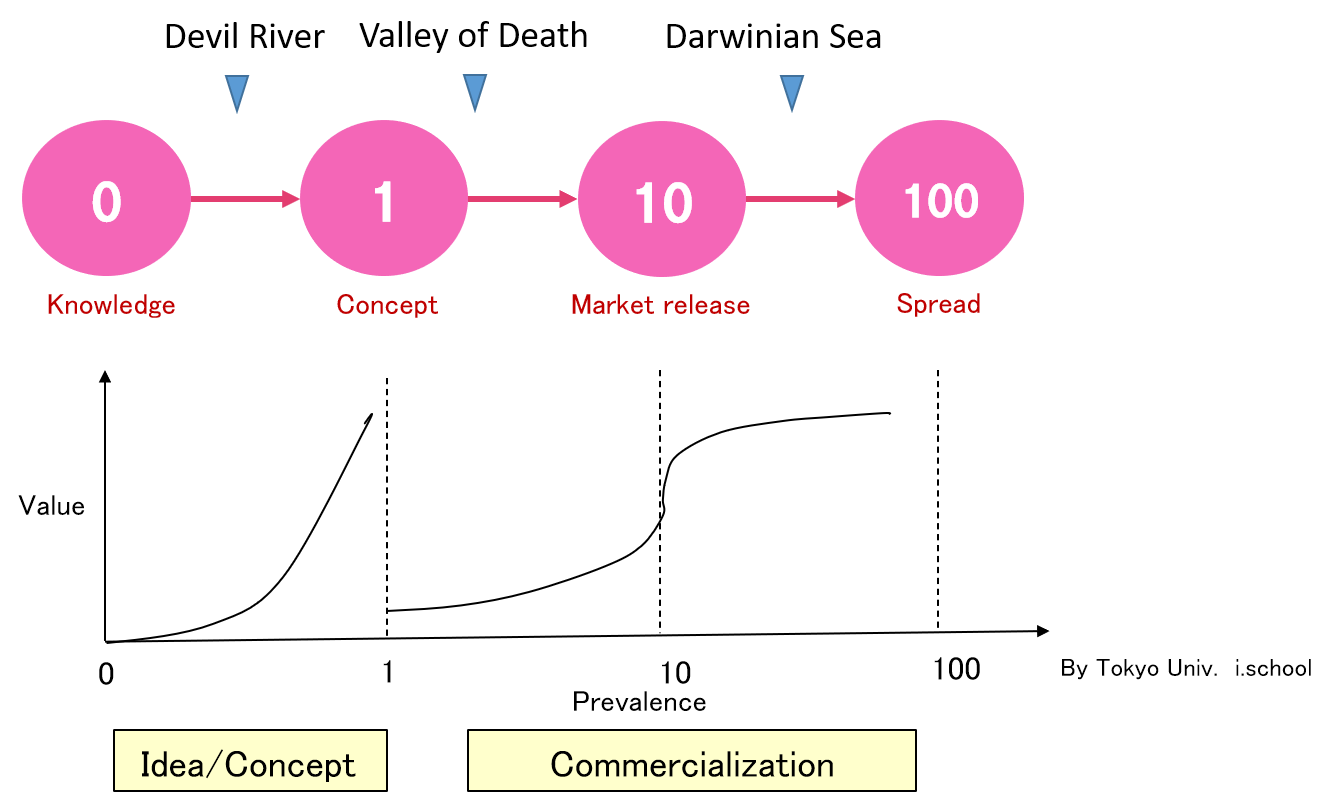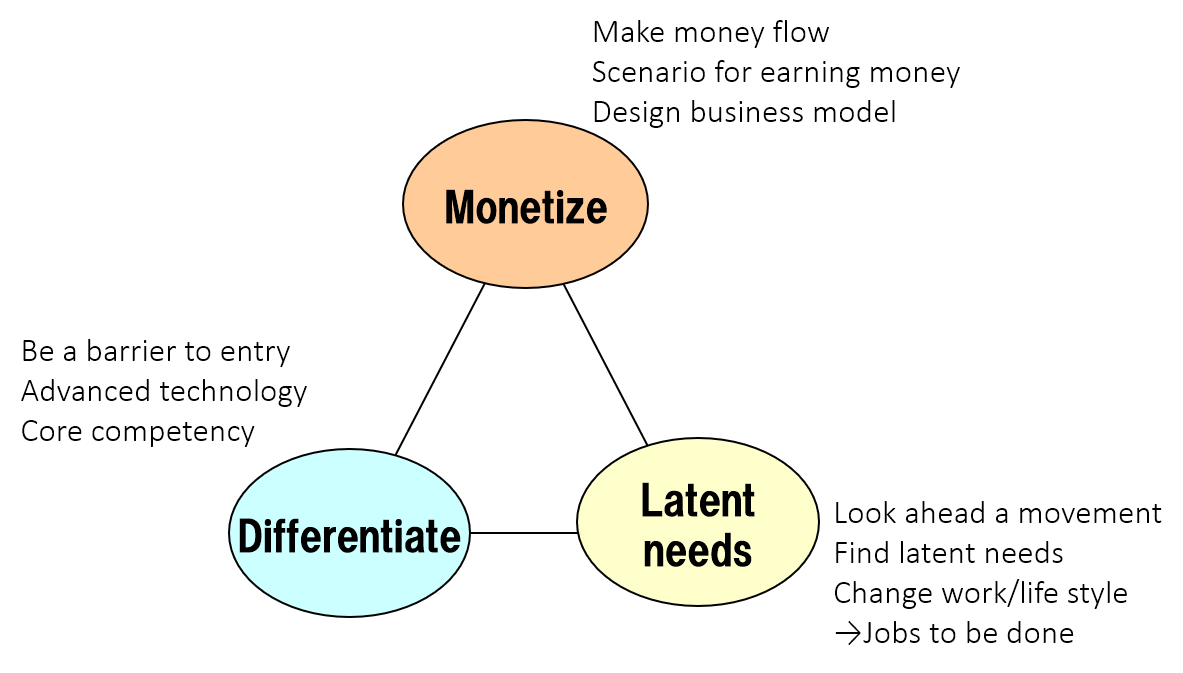

I want to launch a new concept, a new product, a new business, what should I do!?
Existing businesses are also coming to a head. We are proud of our good technology, but we want to take advantage of it to launch a new business, but we don’t know how to do it because there are few people with experience in business development. We want to know what kind of approach we should take in terms of structure, human resources, and strategy.
Based on my experience in promoting open innovation and working on new businesses at a major company, I would like to talk about the key points for launching a new business by leveraging core technologies.
In conclusion, there are five major things you need to do
- Launch R&D marketing
- Utilization of venture companies
- Establishment of POC (Proof of Concept) system
- Design of commercial distribution
- Agree on a business plan
Items 1 through 3 are necessary to derive business ideas by utilizing the company’s technology, and are to be performed mainly by the development division. 4 and 5 are to be performed by the sales and business planning divisions once the business ideas have been finalized to some extent.
In this article, we will discuss the key points from 1 to 3 up to the materialization of a business idea that makes use of the company’s own technology.
Contents of this article
- Points for launching a new business using core technologies
- R&D Marketing Launch
- Utilization of Venture Businesses
- POC (Proof of Concept) system development
- Points for innovation from the viewpoint of Management of Technology (MOT)
- Learning from Management of Technology (MOT)
- Three Opportunities for Innovation
- 3 Elements of a Successful Business
Points for launching a new business using core technologies

We believe that the best way to create businesses that take advantage of in-house technologies is to focus on engineers to develop business ideas.
In many companies, when it comes to launching a new business, a variety of organizations actually raise their hands to enter the market.
The engineers will not know the business, and the planners, sales people, and accounting people will try to develop the business around themselves, but, well, we want to remove organizational barriers and work together.
However, it is the engineers who know the technology of their own company, and it is also the engineers who can make the right decisions regarding the development of new technology and collaboration with the technology of other companies.
In particular, I believe that the engineer-centered team should be responsible for creating a successful business story.
We will explain what needs to be done from the discovery of a business idea that utilizes core technologies to its finalization.
R&D Marketing Launch
The first step is for engineers to change their thinking from a product-oriented approach to a customer-oriented approach.
Instead of searching for so-called “product needs,” engineers are given the task of becoming marketers by learning marketing thinking in order to discover what customers really want to do away from products, and what they themselves are not even aware of.
We share our expertise in incorporating evolving marketing theories such as Kotler’s Marketing 3.0 and 4.0 and the job theory advocated by Harvard Business School Professor Clayton Christensen into new business development.
Organizing R&D marketing with a new marketing sense to keep up with the rapid changes in the market is the first step to successfully developing new businesses.
Reference: A course for engineers to develop marketing thinking skills
We will set up an R&D marketing team, have the team members learn all they need to know as marketers, and then formulate business ideas that use our technology.
We teach the “Job Theory Framework” as a method of business creation using job theory.
Reference article: We teach a framework for practicing job theory
In brief, the following steps are used to develop a business idea.
- Capture customer behavior (jobs) as a story
- Map current solutions for each job
- Create a related business map from the solutions
- Identify customer desires for each solution
- Identification of issues to increase customer satisfaction → Idea generation
- Refinement of ideas → business stories
From customer issues, we generate ideas, match ideas with our own technology, or identify issues lacking in our own technology.
Utilization of Venture Businesses
The next issue is how to match the challenge of increasing customer satisfaction with the company’s own technology, which the company lacks.
There are two ways.
- Develop them in-house from now on.
- Leverage another company’s technology (partnership, acquisition, etc.)
When utilizing other companies’ technologies, alliances with other companies, industry-academia collaborations, and venture companies can be used.
It is best to keep an antenna for all of them, but if you have limited resources, utilizing venture companies is recommended.
This is so-called open innovation. Venture companies are open to their own success and welcome alliances and acquisitions from major companies.
In addition, by watching the venture, you can make contacts with university relations attached behind the venture and with major companies that gather around the venture.
Although venture activity is now much more restricted in Corona, there are still presentations for venture sales at various events, including through online systems.
Many of these events are free to attend, so it is a great way to get a feel for what venture companies are doing, what technology trends they are seeing, and to look for ventures that can complement the technology your company lacks.
In addition, you can learn about the movements of rival companies that are exploring venture businesses, so watching venture companies is a must for any organization launching a new business.
POC (Proof of Concept) system development
If you want to develop technology-based products and services and launch new businesses from there, it is very important to have a system that can quickly turn POC around.
Recently, even in manufacturing companies, engineers are becoming less and less capable of working on their own to create the products that come to mind, and some say that this has led to the weakening of manufacturing companies.
The key to success is to make sure that the business idea is a solid one through repeated trial and error, by creating a system to test whether the customers accept the idea and whether they really want it using the prototype, without saying a word.
A few years ago, there was a cry for “MAKERS MOVEMENT,” and fab spaces were created here and there, but many of them collapsed because they were not viable as businesses.
The business of sharing Fab space did not work out, but I think it is very meaningful to have a small, easy-to-use experimental space within your company for new business development.
Not only for manufacturing, but also for application development, etc., and also as a base for exchanges with venture companies and the outside world, open innovation will be accelerated.
Let’s create a space that can be a HUB for external collaboration, a place where ideas can be developed into business ideas in order to continuously create new businesses, not just one-shot.
The key to innovation from a MOT (Management of Technology) perspective

Once the process is secured for engineers to think from the customer’s point of view, generate ideas, utilize their own technology, identify technologies that the company lacks, and refine the ideas through POC, the next step is to select the real ones from the ideas that emerge.
By creating a state of so-called “prolific production and death,” you can increase the likelihood of generating ideas that will lead to hit products.
From the point of selecting the actual business development from the many ideas, we involve business people in planning, sales, accounting, etc.
This section explains the key points to keep in mind to generate good ideas.
Learning from Management of Technology (MOT)
It is said that three barriers must be overcome in order for a new business to succeed.
- This wall is called the “magic river” where basic research and R&D create new concepts.
- A wall called the “valley of death” that must be crossed at the stage of practical application and commercialization.
- The wall called “Darwin’s Sea,” which must be overcome in order to survive the competition after bringing a product to market.

It is not easy to create a new concept, or a “1” from a so-called “0.
Many Japanese companies, which have built an era through mass production, are good at what is called commercialization, from “1” to “10” to “100,” but they tend to have trouble connecting the creation of “1” from “0” to commercialization.
Even if they have good technologies and ideas, they often fail to fully utilize them and end up wasting them.
We need to match the people and organizations responsible for “0” to “1” with the people and organizations responsible for “1” to “100.
In some cases, such as when an idea that emerged in a research institute is commercialized in a division of a single company, it does not go well due to organizational barriers, the convenience of both parties, or the busyness of the existing business being conducted by the division.
最Recently, many companies are taking up the idea of “open innovation” to address the limitation of creating a new business within a single company, with an awareness of inter-company collaboration and the inclusion of venture companies, but I have not heard of too many successful cases.
The side that does “1” from “0” needs a mechanism to aim for “1.1” from “0,” and the side that does “100” from “1” needs a mechanism to aim for “100” from “0.9.
Let’s promote the launch of business by making both sides aware of “commercialization” and the essence of innovation known within the organization, as well as by building an organizational structure for this purpose.
Reference article: Mechanisms for creating innovation
Three Opportunities for Innovation
Also, while many people tend to understand that innovation is the creation of “1” from “0,” we need to remind ourselves that, in fact, both the valley of death and Darwin’s sea are great opportunities for innovation.
In particular, from a company’s perspective of profitability, the breakthrough after approaching “100,” or Darwin’s sea, is a great opportunity for innovation, and it is important to be aware that there are multiple opportunities and to allocate resources appropriately to the three walls
Many engineers tend to think that the Devil’s River is the main source of innovation and the Valley of Death is the sub source, but I believe that many people do not realize that all three are actually opportunities for innovation, and that the Darwinian Sea has the greatest impact on both customers and the company.
It is important to be aware of the three opportunities and innovate strategically.
Reference article: Crossing the “Darwinian Sea”
Three Elements of a Successful Busines
Creating a business is not about creating a product or service, but about moving money through the product or service.
No matter how good the product is, if it does not make money, it cannot be called a successful business.
Even if you use the most advanced technology, if it is not something that customers want, they will not buy it.
Even if there is a need for a product, it will not become a hit unless there is a reason why people choose to buy from your company.
The condition for success is to build a development strategy and an internal structure that will satisfy all three of these three elements: customer needs, differentiation, and business model.

At the stage of considering new business, engineers tend to focus on the technical aspects, or differentiation.
Conversely, business people tend to focus on the needs.
The area that tends to be neglected the most is how to make money.
Surprisingly few people, whether engineers or business people, can see the balance between the three key elements from their experience.
A business cannot exist if any one of the three is missing.
When filtering through a multitude of ideas in a prolific and prolific business, it is necessary to have people who can see the balance between these three factors.
This is the kind of talent that so-called venture capitalists possess.
One of the characteristics of companies that do not succeed in launching new businesses may be the lack of such talent.
If you liked this article, please click the “Like” button below!!

